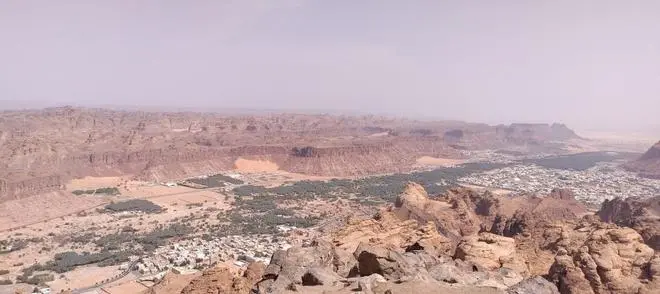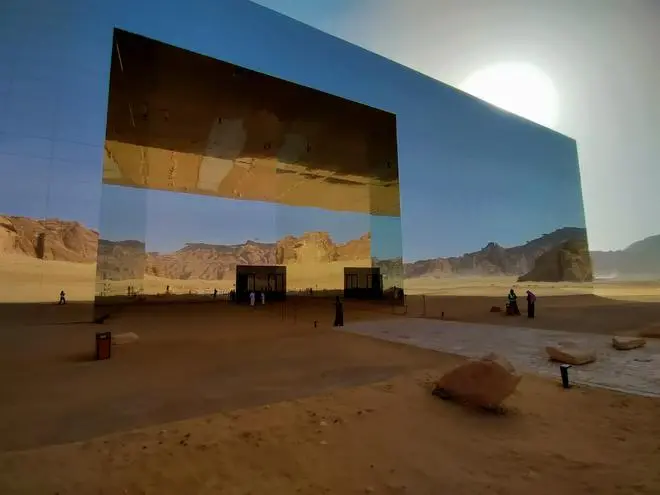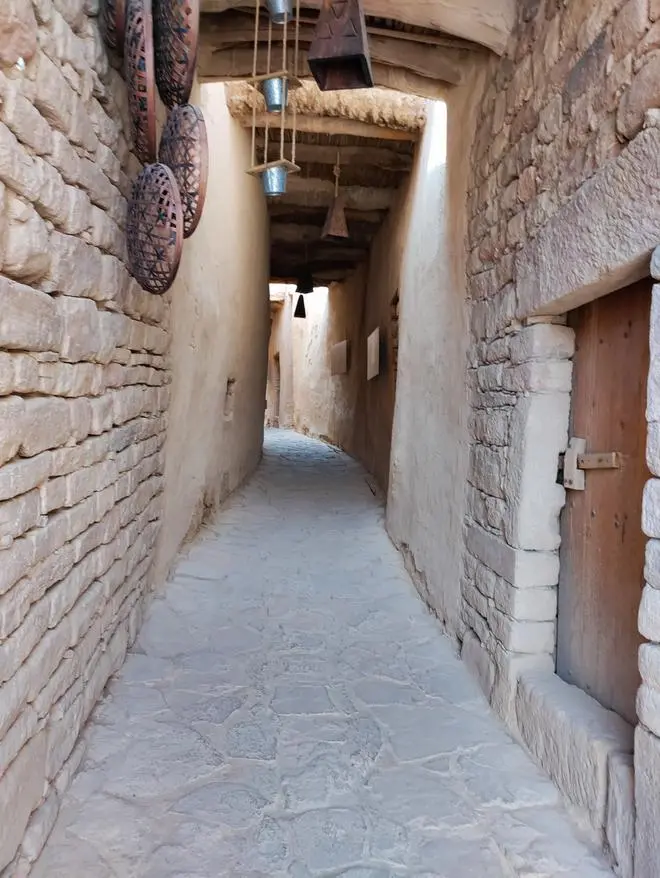If you are taken to blindfolded to this place and if you swear, when the cloth is removed, that you are somewhere in Utah or Arizona, USA, you would be forgiven for the wrong guess. This vast desert of beige sands relieved only by short, nondescript shrubbery, stand tall sandstone cliffs, chiselled and carved into incredible shapes and forms by relentless beat of the sun, wind and time, do resemble the better-known deserts of the US.
But this place is thousands of miles from the US, in the rough deserts of Saudi Arabia. It is called AlUla.
From six centuries before Jesus Christ was born, AlUla was at the crossroads of trading routes until motorised travel became the norm. Tired camels rested, and travellers bought food and water for their onward journey.
Today, AlUla has become a symbol of the transformation underway in Saudi Arabia. Under its ruler Mohammed bin Salman Al Saud, Saudi Arabia is trying to morph itself from a dead desert country whose only claims to fame are the holy Mecca and crude oil into a vibrant, modern, liberal nation—like its neighbours Dubai, Abu Dhabi and Qatar.

The green palm grove and the ‘old town’ as seen from Harrat view point | Photo Credit: M Ramesh
Located midway between Medina and the Suez Canal region AlUla is quite far from anywhere. In the middle of the sandstone cliffs, where the oasis used to be, lies the township of AlUla, home to 45,000 inhabitants—not a hotspot for building an international airport. But AlUla has one, illustrating Saudi Arabia’s strategy of creating infrastructure ahead of development. The terminal building is small, but the roads leading to it from the township are huge, indicating expectations of their future use.
A meld of history and geography
Today, few would think of Saudi Arabia when they plan a vacation, and this is exactly what the country wants to change. Broad roads from Medina and Jeddah in the South and Tabuk in the North cut through the rocky, Mars-like deserts to provide access AlUla—but the roads are mostly empty most of the time. Saudi Arabia is on a mission to make this place a global tourist attraction and is dressing it up for that. It is a good choice, for AlUla is a nice meld of history and geography—it was the capital of ancient Lihyan and Nabatean kingdoms and can today boast of some spectacular rock formations; as such, it has plenty to offer to a restless tourist.
Postcard delights

The 171-ft Elephant Rock is one of the delights of AlUla | Photo Credit: M Ramesh
To start with, the desert and the majestic pre-Cambrian sandstone cliffs, which were under the sea some 500 million years ago and formed by the compression of sediments like sand, silt, pebbles and dead animals, provide such pleasing picture-postcard delights that you can keep watching all day. The oasis doesn’t exist, but the waters still flow underground, giving life to a large grove of date palm and orange, which looks like a brush-stroke of lush green amidst an arid desert. A 30-minute drive takes you to Hegra, a cemetery of a hundred tombs hewn into a red outcrop, to get a glimpse of the past. Go to Harrat, up on a volcanic hill, you get some delightful views of the entire stretch of AlUla, including the modern township.
Up there at Harrat everything is black and, drawing inspiration from that natural colour, they have built an open-air restaurant where everything from the walls to the cutlery to the waiters’ dress to table cloth all pitch black. Even tour guides get excited as they point to the features of the township below and say “over there, that is Hegra, the open space beyond that is where hot air balloon station is; this rock there is Dadan and that’s the ‘old town’.

HIll top restaurant at Harrat | Photo Credit: M Ramesh

The entire stretch of AlUla as seen from Harrat view point | Photo Credit: M Ramesh
However, the Royal Commission of AlUla, set up by the government, is packing the place with man-made attractions to complement the natural ones. Art is a focus area— today abounds with examples of artistic expressions. DesertX is a good example, where this writer saw sculptures, progression of walls with wave motifs, origami in stainless steel, a ‘mirage’ made of stainless steel, abstract geometric shapes covered in discarded camel skins—plenty of them lying in the desert, open to the sky. For more art, you go to the nearby Maraya, which features the world’s biggest mirrored building pregnant with artworks, mostly, but not exclusively, by Arabs.

The reflected images on the mirrors are sometimes indistinguishable from the backdrop | Photo Credit: M Ramesh
The emphasis on art is also evident from the training school recently set up by the Royal Commission, which trains locals in commercial arts such as pottery, jewelry and basket making—paying the 70-odd trainees a monthly stipend of $900.
The Commission is also building back the ‘old town’. Walking through narrow alleys and mud houses transports you centuries back in time. When completed, the Old Town would feature 900 ‘houses’, so that you can really walk through history. This penchant for preserving the past as it was is evident in several places in Saudi Arabia, such as in Jeddah, which also has an Old Town.

Old Town: Bringing history back to life | Photo Credit: M Ramesh
Add to this mix, a star-gazing opportunity and a hot air balloon or helicopter sightseeing, there is indeed a lot for a tourist. And don’t worry about the weather—it seldom gets hotter than 36°C.
Vision 2030
In 2016, Prince Mohammed bin Salman unveiled ‘Saudi Vision 2030’, a framework to reduce the country’s dependence on oil, diversity its economy and develop health, education and tourism. The Neom city project (a futuristic city), King Salman Park Foundation and Sports Boulevard Foundation are some of the projects under Vision 2030, but AlUla development is at the core of the modernization of Saudi Arabia.
Saudi Arabia is a country in hurry to change. Physical changes are palpable, but the grip of conservatism is easing only slowly. If you are a foreigner and a woman, nobody will arrest you if you go around with your face uncovered, but you should expect a volley of Arabic invectives from an elderly woman. Nobody wears shorts, not even the tourists. But despite the conservatism--in which the locals take pride--the country is transforming. This writer chatted up a number of hotel staff of Indian origin (most of them unsurprisingly from Kerala) and they all said that Saudi Arabia had changed a lot in the last few years.

Sandstone rocks and beige sands--typical AlUla landscape | Photo Credit: M Ramesh
It is hard to miss the competition among the Arab nations of UAE, Qatar and Saudi Arabia. With jewels like Dubai and Abu Dhabi, UAE seems to be well ahead, having begun modernizing quite early. Qatar is aggressive making Qatar Airways its brand ambassador and holding international events (Doha Round of WTO in 2001, FIFA World Cup in 2022). And now, Saudi Arabia, with deep pockets full of money and dreams, has thrown its hat into the ring. AlUla is one of the engines it wants to employ for its journey to the top.
(This writer’s visit to AlUla was sponsored by the Royal Commission of AlUla.)





Comments
Comments have to be in English, and in full sentences. They cannot be abusive or personal. Please abide by our community guidelines for posting your comments.
We have migrated to a new commenting platform. If you are already a registered user of TheHindu Businessline and logged in, you may continue to engage with our articles. If you do not have an account please register and login to post comments. Users can access their older comments by logging into their accounts on Vuukle.